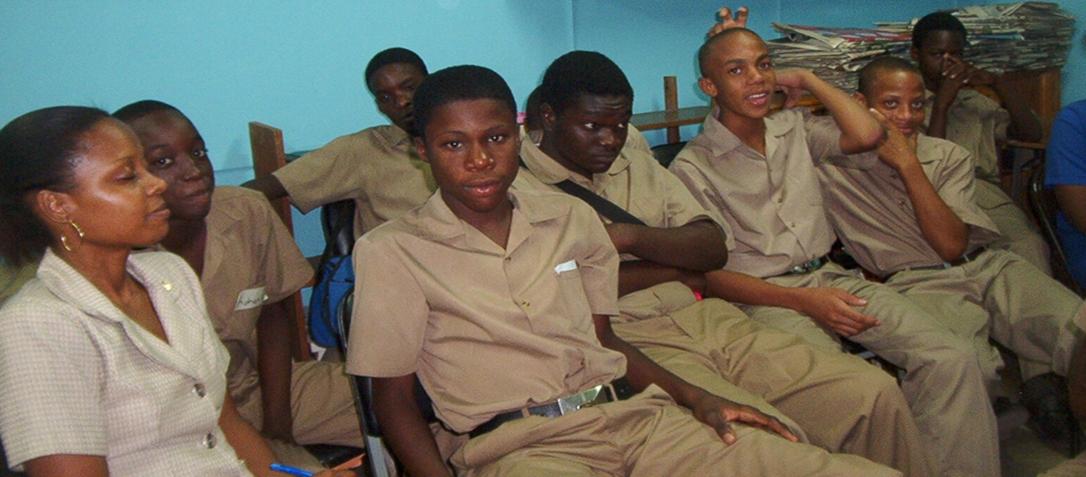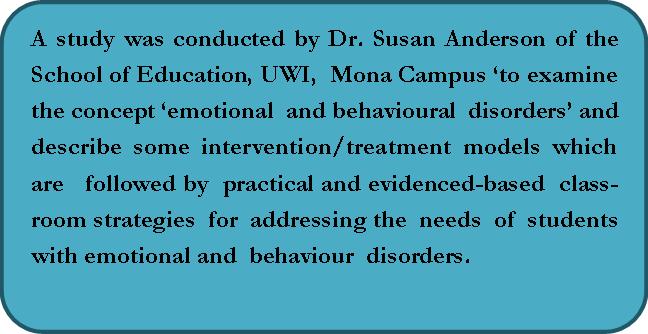EduFocus # 18: Psycho-Educational Processes as Strategies for Students Presenting with Emotional and Behavioural Disorders
 Children whose behaviour is not considered ‘normal’ are often treated with a lack of understanding and empathy on the part of teachers and their peers. Such treatment leads to negative student behaviour and resultant poor perfomance. Amongst these children are those with special needs and learning disabilities. They suffer most at the hands of teachers and administrators who construe exceptionalities such as hyperactivity and aggression as rude and disgusting. This is due to their inability to identify children with emotional and behavioural disorders. The Jamaican educational system is woefully unprepared to cater to the needs of these children.
Children whose behaviour is not considered ‘normal’ are often treated with a lack of understanding and empathy on the part of teachers and their peers. Such treatment leads to negative student behaviour and resultant poor perfomance. Amongst these children are those with special needs and learning disabilities. They suffer most at the hands of teachers and administrators who construe exceptionalities such as hyperactivity and aggression as rude and disgusting. This is due to their inability to identify children with emotional and behavioural disorders. The Jamaican educational system is woefully unprepared to cater to the needs of these children.
CHARACTERISTICS OF EMOTIONAL AND BEHAVIOURAL DISORDERS
Emotional and Behaviour Disorder (EBD) is defined in this paper as a disability that is characterized by behavioural or emotional responses in school programmes so different from the appropriate age, cultural, or ethnic norms that the responses adversely affect educational performance, including academic, social, vocational or personal skills. Students with EBD display characteristics such as physical abuse of others, having no regard for other people’s property, indifference to other people’s feelings, lack of empathy and having learning challenges which are difficult to explain. There are, however, cultural differences in defining EBD, with the result that while in some cultures autism and schizophrenia are included, in others, they are not considered as EBD.
EBD falls under three groups. First is the group characterized by externalizing behaviours. Children in this group are disruptive, hyperactive and aggressive. They tend to be mostly boys. In contrast, there are children with internalizing behaviours who tend to be withdrawn, anxious, inhibited and prone to depression. Children in the third group show a low incidence of disorder in that they manifest the disorder infrequently. However, when they do, the disorder is very serious. Children with schizophrenia fall into this group.
Should children who exhibit these disorders be mainstreamed into regular classrooms? Opinions are divided on this. The Jamaican Ministry of Education has a Special Education Unit but it has not yet created a national system where children can be assessed, referred and programmes planned and implemented to meet the needs of children with EBD. There are various intervention models that could be used; for example, the biosocial interaction model of childhood externalizing behaviour which focuses on the prevention of maternal malnutrition, smoking and use of drugs during pregnancy as well as psychosocial risks such as poverty and high psychosocial stress which can lead to the child developing EBD. This paper focuses on the Behaviour Modification Model (BMM) which requires the teacher to identify the maladaptive behaviour that interferes with learning and to aid in the development of more adaptive behaviours. The model is based on B. F. Skinner’s theory of operant conditioning. The BMM was extended by the use of computer-aided instruction.

MAIN FINDINGS
Teachers’ experiences showed that children who misbehaved are labelled as deviants and subject to corporal punishment. For example, a male student who was labelled as “just seeking attention and having a poor work attitude” was subsequently diagnosed as suffering from Attention Deficit Hyperactivity Disorder (ADHD) and really needed treatment to address his problem. The teachers felt that the training that they had received at Teachers College did not adequately prepare them to treat with children with EBD and so they had to use their own initiative. For example, one of the teachers reported that she used computer aided instruction to encourage children to want to learn. They soon learnt that their misbehaviour would result in them being denied the privilege of going to the computer room. As part of the intervention, the children were given the task of using technologies they had at their disposal to produce a video of the activities they were involved in for the duration of the programme. They used cellular phones, video cameras to take photographs and they selected music from their iPods to use in the production of the video. On the final day of the programme photos, music and video clips were uploaded on the laptop to produce the video. Using Windows Movie Player, students were able to work with each other in creating a video of the intervention in which they were all involved. At the end of the process, students expressed their appreciation in learning a skill that not only enabled them to channel their energies in a positive direction but also helped them to understand how to work with others in achieving common goals.

SOME IMPLICATIONS FOR TEACHING AND LEARNING
• It is essential for teachers to know that children with EBD are not problem children but children with real problems not willed by them but caused by their disorder. Punishing them will only exacerbate the situation.
• Teachers need to treat each child separately by looking at his or her individual diagnoses carefully, noting the different types of behaviour and being mindful of the particular strengths and weaknesses of the child.
• In treating with children with EBD, teachers should incorporate the use of technology, especially the computer, since it can be helpful to the child. The computer does not criticize the child who is using it and it facilitates learning with out the pressure of being judged in a subjective manner.
• Teachers need to be trained to cope with children with EBD. They need standards and significant guidelines to help them to create meaningful experiences for these children in their classrooms.
• The Ministry of Education in Jamaica and other countries in the Caribbean which face similar problems need to put in place a national system for diagnosing, assessing and referring children with EBD, as well as for planning and implementing programmes that address their individual needs.

 Visit our Help Center to find answers to frequently asked questions.
Visit our Help Center to find answers to frequently asked questions.